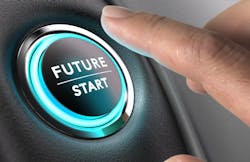One look at the news coming from the automotive industry and it’s obvious that autonomous vehicles are a hot topic in the industry. There’s a frequent news cycle about new technologies, companies entering the playing field and the ways in which it could disrupt the transportation industry.
However, there’s one aspect of the emerging technology that’s rarely discussed: its impact on auto repair shops and vehicle maintenance.
More specifically, how service centers of the future fit into this landscape if self-driving vehicles were to become mainstream.
And according to Manas Mudbari, founder and CEO of artificial intelligence company Lexeme and a former industry analyst, despite the threat, there’s also an opportunity there for independent repair shops.
“I’ll give you an example of Blockbuster and Netflix,” he says. “When Netflix was a tiny startup, Blockbuster was laughing at them. Now, they’re bankrupt. Repair shops need to think of what could happen in the future, instead of preserving the bottom line right now. You never know when laws in Congress might change and autonomous vehicles get on the road. Then you have no technology and you’re out of business.”
Ratchet+Wrench recently sat down with Mudbari to discuss how repair shops could be effected, and most importantly, the keys to thrive during this time.
As a driver is removed from the car, there’s, naturally, not anyone to report a vehicle malfunction. How do you see the OE getting more involved?
To tackle this problem, predictive maintenance concept will likely be introduced during the manufacturing process. Predictive maintenance involves constantly analyzing streaming data in order to maximize machine uptime and predict failure. Also, as time evolves, we could see machine learning algorithms provide more sophisticated and precise failure predictions. This similar technique can be applied in autonomous vehicles, as well.
That’s where I’m really worried for the independent shops. The OEs are going to hold all the data in terms of what’s happening with the vehicles. You have OBD-II systems today, but, in the future, that might be obsolete. That way, the car manufacturer will hold all the data. That’s an advantage for a dealer service center, but how does that data get to the repair shop? I’d say the best way is to partner with the OEs, likely through certifications.
One criticism of these new technology companies that pop up is that they’re acquired quickly by OEs and then dissolved.
Everyone is trying to put money into it. General Motors acquired Cruise Automation for $1.2 billion. They weren’t that old. I have heard that criticism, but I think, from my point of view, even if it’s absorbed and not mainstream, little by little, these OEs are going to use the technologies.
What could the maintenance costs look like?
According to a report published by Boston Consulting Group, with autonomous cars, all new parts and technologies need to be considered, thereby adding up to the cost. Costs of expensive parts like LiDAR could run up to few thousands, given it is the core technology in autonomous vehicles.
Any new technology that comes up, there’s going to be so much R&D going into that, the cost will go down. For example, phones used to be so expensive, but they went down. LiDAR is still so expensive because it’s so new. In 5-10 years, there will be so many more companies and the price will go down, especially for autonomous vehicles to achieve commercial scale.
As autonomous cars are mostly run by underlying operating software, maintenance can be done via over-the-air updates. How much will still need to be physically repaired?
Newer car parts like LiDAR and processing units still need to be physically repaired. In this case, traditional technicians will have to acquire some transforming skills to be able to deal with these technologically advanced vehicles.
As services intervals are constantly being extended by the manufacturers, we believe in the world of autonomous vehicles, auto repair shops will also see majority of their customers less frequently.
How can independent repair shops survive?
Hybrid and electric vehicles will keep gaining the market share in the next few years, too, along with autonomous vehicles, which will force mechanical shops to upgrade.
With all of these upgrades, the question is, will these shops have the talent to do these kind of procedures? I think that’s something we should be thinking about. We need talent that has knowledge of how these systems work. In terms of the new technology getting embedded, if they work like a software company and hire engineers, and such, they might look into hiring more software engineers, which will help figure out how to figure out OTA updates. Having that mindset is helpful.
As the industry shifts from individual car ownership to fleet ownership, I would recommend indy repair shops start partnering with companies that operate fleets, be it autonomous or just a smaller fleet.
What advantage do independent repair shops still have?
Obviously technology is going to change a lot, but it’s not going to change the human aspect. The relationship. People smiling at you. Feeling like a member of the family. That kind of a thing—technology can’t replace. Whoever you do business with, you want to do business with. There’s a trust factor. That’s the advantage those shops have.
